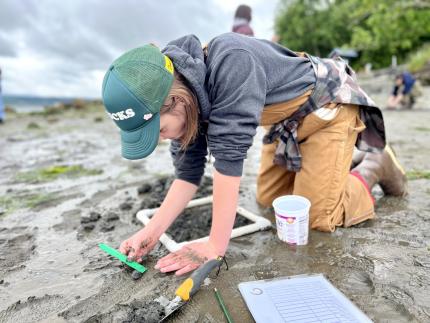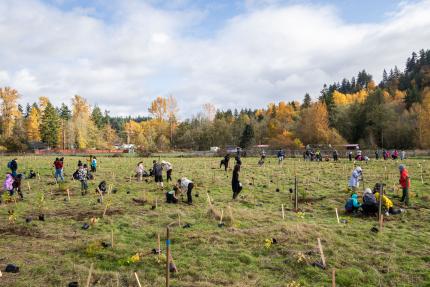Media Contact
Katy Payne she/her
360-764-0201
In the heart of the Nisqually River Basin, a school program is opening the floodgates of knowledge for local students.
Davy Clark, Program Director for the Nisqually River Education Project, helps students learn about salmon ecology and water testing for the Nisqually River. Students learn how to take river samples, complete macroinvertebrate surveys, and conduct experiments in nearby estuaries to measure stormwater runoff.

"So many kids, when we take them to their river, tell us that it's the first day they've ever been to a river," said Clark. "It’s the first day we’re consciously visiting a river and thinking about the river as a living system that is … supporting salmon and other wildlife, all of us. There's people fishing, and we're chatting with them because somebody caught something, and all the kids get excited, and it just kind of brings everything to life."
The Nisqually River Education Project, a program of the Nisqually River Foundation, takes students on outdoor trips to the Nisqually Watershed, immersing students in the living ecosystems outside of the classroom. These local experiences help students become more engaged with nature and increase their understanding of science taught in the classroom.
Clark's program is funded by Washington state's Outdoor Learning Grant Program, which creates opportunities for students to participate in outdoor education as a part of their public education curriculum.
The Outdoor Learning Grant program was created by the Legislature in 2022. Grant recipients represent the various regions of Washington state and their programs must be accessible for students with disabilities.
The Legislature created the program to support grants via three avenues:
- Schools and school districts for outdoor learning programming,
- Community-based organizations (CBOs), and
- Overnight outdoor school experiences.
Clark's program is funded by the second bucket, which is administered by the Washington State Recreation and Conservation Office (RCO).
Sheila Wilson, the Outdoor Education Program Manager for OSPI, works with schools across the state to increase access to outdoor learning opportunities.
“Outdoor education is good for kids because it increases attention, decreases anxiety, improves attendance, and improves graduation rates,” she said.
Research also shows that time in nature fosters better social skills, increases self-esteem, and creates stronger emotional connections to people and nature.
Washington is one of a handful of states that funds outdoor learning programs. An integral aspect of Washington's Outdoor Education Program is its collaboration with tribes. This partnership emphasizes the importance of connecting students with the rich cultural and ecological heritage of indigenous communities. Tribal youth learn traditional environmental knowledge from elders, empowering them as stewards of their culture, lands, and waters.

"It stitches the communities more closely together with their schools because there's great value, not just for the students, but [for everyone]," Wilson said. These programs “foster the next generation's sense of agency and stewardship in their community. [These students] have the ability to make a difference locally for the climate, for their water, for wildlife."
Clark's program serves local students, including those who are members of the Nisqually Indian Tribe. Clark aims to show students that the future of the world is "something that [they] have a voice in." It's what makes him proud to do the work that he's doing with public schools in the local community.
Students engage in a range of activities that contribute to environmental conservation and community development. These activities include habitat restoration, tree planting, and water monitoring efforts. Specific projects, such as prairie restoration in Pullman and the preservation of Ponderosa pines near Spokane, exemplify the diverse range of environmental initiatives that students undertake throughout Washington state.
“We’re doing different things, but the common thread [is] how can we get the student to see how much they are a part of their environment,” said Clark.
Students also learn various skills that would be difficult to learn in the classroom. Outdoor education programs focus on environmental stewardship, which helps students learn more about career paths that work with nature.
Clark tells his students that the activities they do in his program are the same ones they would do in nature-related jobs.
"We're creating experiences [for] students," Clark said. "You can either be a water quality technician or a restoration ecologist, and take that path. … Then you're going to come back and teach each other about what you did because people had different experiences during that day."
This integrated approach allows students to practice scientific processes, like collecting water samples, and incorporate these activities into what students are learning in the classroom.
The students “were taking ownership of their learning … and that piece has been so rewarding," Clark said.
In one of his groups, students created posters highlighting the significance of water quality testing and its broader impact on the environment, including salmon populations.
"They were looking at the salmon's nostrils and talking about how important their sense of smell is for the ability to navigate back to their home streams," he said.
Clark believes outdoor education is essential to children learning because students walk away with a deep appreciation of the environment, their community, and their future.
"I think a common thing that we hear is students say, 'I'm kind of like a scientist today,’” Clark said. He then says to them, “'You are a scientist today.' And watching them just like light up when we acknowledge that — it's huge."






